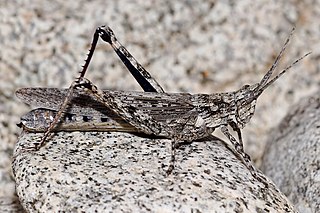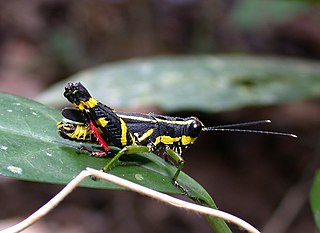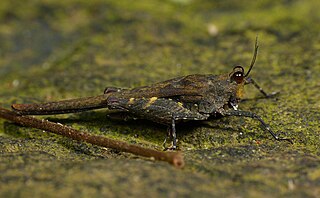
Acrididae, commonly called short-horned grasshoppers, are the predominant family of grasshoppers, comprising some 10,000 of the 11,000 species of the entire suborder Caelifera. The Acrididae are best known because all locusts are of the Acrididae. The subfamily Oedipodinae is sometimes classified as a distinct family Oedipodidae in the superfamily Acridoidea. Acrididae grasshoppers are characterized by relatively short and stout antennae, and tympana on the side of the first abdominal segment.

Conocephalus is a genus of bush crickets, known as coneheads. It was described by Carl Peter Thunberg in 1815.

Chorthippus is a large genus of acridid grasshoppers with around 230 described species. The genus may be subdivided into subgenera including: Altichorthippus, Chorthippus and Glyptobothrus, with other species not placed.

Tetrigidae is an ancient family in the order Orthoptera, which also includes similar families such as crickets, grasshoppers, and their allies. Species within the Tetrigidae are variously called groundhoppers, pygmy grasshoppers, pygmy devils or "grouse locusts".

Phaesticus is a genus of groundhoppers found in Malesia and Indo-China.

Scelimena is a genus of ground hoppers in the family Tetrigidae, with records from India, Indo-China, Malesia and Papua New Guinea.

Caryanda is a large genus of grasshoppers in the subfamily Caryandinae. Species are recorded from Africa and Asia.
Scelimeninae is a subfamily of ground hoppers belonging to the Tetrigidae family of Orthopterans.

Traulia is a genus of grasshoppers in the subfamily Catantopinae; it was considered typical of tribe Trauliini, but is now placed in the tribe Mesambriini. A majority of species found in South-East Asia.

Metrodorinae is a subfamily of groundhoppers or pygmy grasshoppers. There are at least 90 genera and more than 590 described species, found in South America, Africa and Asia.

Eucriotettix is a genus of ground-hoppers in the tribe Thoradontini. Species have been recorded from tropical Asia: India, Indochina, through to New Guinea.
Bolivaritettix is an Asian genus of ground-hoppers in the subfamily Metrodorinae and not assigned to any tribe.
Austrohancockia is an Asian genus of ground-hoppers in the subfamily Cladonotinae and not assigned to any tribe.
Epitettix' is a genus of ground-hoppers in the subfamily Cladonotinae and not assigned to any tribe; records are from Madagascar and Asia.
Deltonotus' is an Asian genus of ground-hoppers in the subfamily Cladonotinae and tribe Cladonotini.

Criotettix is an Asian genus of ground-hoppers in the tribe Criotettigini.
Mazarredia is an Asian genus of ground-hoppers in the subfamily Metrodorinae and not assigned to any tribe.
Macromotettix is an Asian genus of ground-hoppers in the subfamily Metrodorinae and not assigned to any tribe.
Podismopsis is a genus of grasshoppers in the subfamily Gomphocerinae and tribe Chrysochraontini, erected by Zubovski in 1900. Species have been recorded from central Europe through to temperate east Asia, including Japan.










